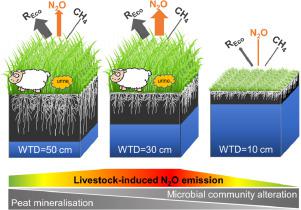Resources, Conservation and Recycling ( IF 11.2 ) Pub Date : 2021-07-01 , DOI: 10.1016/j.resconrec.2021.105764 Yuan Wen , Benjamin Freeman , Danielle Hunt , Samuel Musarika , Huadong Zang , Karina A. Marsden , Chris D. Evans , David R. Chadwick , Davey L. Jones

|
Drained peatlands support highly profitable agriculture, but also represent a globally important source of greenhouse gas (GHG) emissions. Grasslands can typically be maintained at higher water levels than croplands, so conversion of cropland to grassland represents a potential CO2 mitigation strategy that allows for continued agricultural production. However, the presence of high water levels and livestock on grasslands risks generating high emissions of N2O, particularly associated with livestock urine patches. In the present study, a controlled mesocosm experiment was carried out to quantify the interactive impacts of groundwater level (10 cm, 30 cm and 50 cm water table depth, WTD) and sheep urine deposition on GHG emissions from peat soils. Our results showed that N2O emissions were significantly higher at 30 cm for both urine-treated and control mesocosms, due to the conditions favouring the interplay of nitrification and incomplete denitrification. The urine N2O emission factor was 0.25±0.17% at the 30 cm WTD and 0.20±0.07% at 50 cm WTD, lower than typical values for grasslands. No significant difference was observed in ecosystem respiration or methane flux between 30 cm and 50 cm WTDs. Overall, we conclude that strategies to raise water levels in drained peatlands through conversion of cropland to grassland need to account for the potential impacts of N2O emissions when seeking to minimise overall GHG emissions. Shifting from cropland to grassland management on peatlands for climate change mitigation also requires consideration of the effects of livestock methane emissions, and displaced emissions resulting from increased land demand for crop production elsewhere.
中文翻译:

牲畜引起的 N 2 O 排放可能会限制将农田转变为放牧草地作为农业泥炭地温室气体减排策略的好处
排水泥炭地支持高利润的农业,但也是全球重要的温室气体 (GHG) 排放源。草地通常可以保持在比农田更高的水位,因此将农田转化为草地代表了一种潜在的 CO 2减排策略,允许持续的农业生产。然而,草原上高水位和牲畜的存在可能会产生大量的 N 2 O排放,尤其是与牲畜尿斑有关的排放。在本研究中,进行了受控中观实验以量化地下水位(10 厘米、30 厘米和 50 厘米地下水位深度,WTD)和绵羊尿液沉积对泥炭土壤温室气体排放的交互影响。我们的结果表明,N 2由于有利于硝化作用和不完全反硝化作用的条件,尿液处理和对照的中胚层在 30 cm 处的 O 排放量显着更高。尿液 N 2 O 排放因子在 30 cm WTD 处为 0.25±0.17%,在 50 cm WTD 处为 0.20±0.07%,低于草原的典型值。30 cm 和 50 cm WTD 之间的生态系统呼吸或甲烷通量没有显着差异。总的来说,我们得出结论,通过将农田转化为草地来提高排水泥炭地水位的策略需要考虑 N 2的潜在影响寻求最小化总体温室气体排放时的 O 排放。为了减缓气候变化,从农田转向草地管理泥炭地还需要考虑牲畜甲烷排放的影响,以及其他地方作物生产的土地需求增加导致的排放转移。











































 京公网安备 11010802027423号
京公网安备 11010802027423号